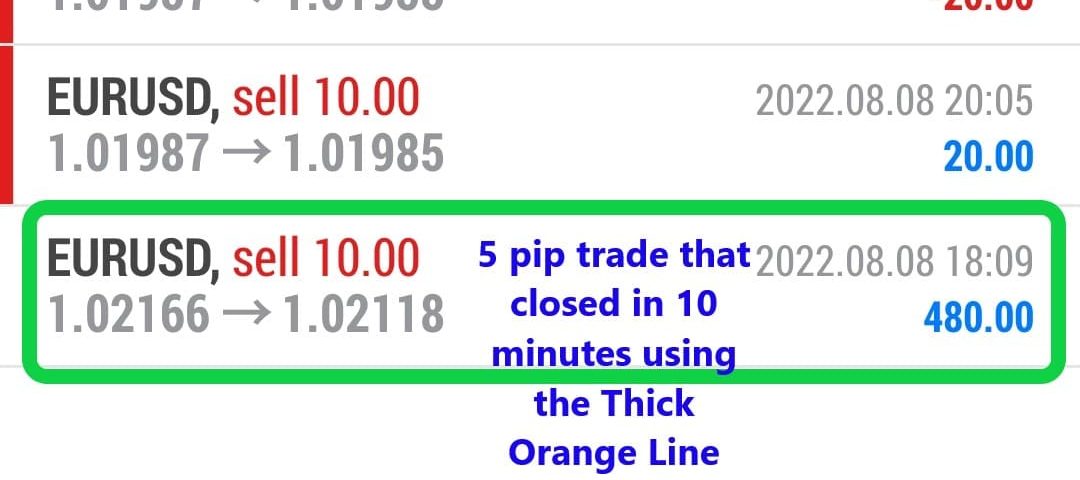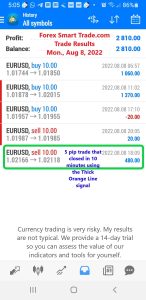Or €100? Or £100?
Since margin trading allows you to open trades with just a small amount of money, it’s certainly possible to start trading forex with a $100 deposit.
But should you?
Let’s see what can happen if you do.
In this trading scenario, your retail forex broker has a Margin Call Level of 100% and a Stop Out Level of 20%.
Now that we know what the Margin Call and Stop Out Levels are, let’s find out if trading with $100 is doable.
If you have not read our lessons on Margin Call and Stop Out Levels, hit pause on this lesson and start here first!
Step 1: Deposit Funds into Trading Account
Since you’re a big baller shot caller, you deposit $100 into your trading account.
You now have an account balance of $100.
This is how it’d look in your trading account:
| Long / Short | FX Pair | Position Size | Entry Price | Current Price | Margin Level | Equity | Used Margin | Free Margin | Balance | Floating P/L |
| – | $100 | – | $100 | $100 | – |
Step 2: Calculate Required Margin
You want to go short EUR/USD at 1.20000 and want to open 5 micro lots (1,000 units x 5) position. The Margin Requirement is 1%.
How much margin (“Required Margin“) will you need to open the position?
Since our trading account is denominated in USD, we need to convert the value of the EUR to USD to determine the Notional Value of the trade.
€1 = $1.20 €1,000 x 5 micro lots = €5,000 €5,000 = $6,000
The Notional Value is $6,000.
Now we can calculate the Required Margin:
Required Margin = Notional Value x Margin Requirement $60 = $6,000 x .01
Assuming your trading account is denominated in USD since the Margin Requirement is 1%, the Required Margin will be $60.
Step 3: Calculate Used Margin
Aside from the trade we just entered, there aren’t any other trades open.
Since we just have a SINGLE position open, the Used Margin will be the same as Required Margin.
Step 4: Calculate Equity
Let’s assume that the price has moved slightly in your favor and your position is now trading at breakeven.
This means that your Floating P/L is $0.
Let’s calculate your Equity:
Equity = Balance + Floating Profits (or Losses) $100 = $100 + $0
The Equity in your account is now $100.
Step 5: Calculate Free Margin
Now that we know the Equity, we can now calculate the Free Margin:
Free Margin = Equity - Used Margin $40 = $100 - $60
The Free Margin is $40.
Step 6: Calculate Margin Level
Now that we know the Equity, we can now calculate the Margin Level:
Margin Level = (Equity / Used Margin) x 100% 167% = ($100 / 60) x 100%
The Margin Level is 167%. At this point, this is how your account metrics would look in your trading platform:
| Long / Short | FX Pair | Position Size | Entry Price | Current Price | Margin Level | Equity | Used Margin | Free Margin | Balance | Floating P/L |
| – | $100 | – | – | $100 | – | |||||
| Short | EUR/USD | 6,000 | 1.20000 | 1.20000 | 167% | $100 | $60 | $40 | $100 | $0 |
EUR/USD rises 80 pips!
EUR/USD rises 80 pips and is now trading at 1.2080. Let’s see how your account is affected.
Used Margin
You’ll notice that the Used Margin has changed.
Because the exchange rate has changed, the Notional Value of the position has changed.
This requires recalculating the Required Margin.
Whenever there’s a change in the price for EUR/USD, the Required Margin changes!
With EUR/USD now trading at 1.20800 (instead of 1.20000), let’s see how much Required Margin is needed to keep the position open.
Since our trading account is denominated in USD, we need to convert the value of the EUR to USD to determine the Notional Value of the trade.
€1 = $1.2080 €1,000 x 5 micro lots = €5,000 €5,000 = $6,040
The Notional Value is $6,040.
Previously, the Notional Value was $6,000. Since EUR/USD has risen, this means that EUR has strengthened. And since your account is denominated in USD, this causes the position’s Notional Value to increase.
Now we can calculate the Required Margin:
Required Margin = Notional Value x Margin Requirement $60.40 = $6,040 x .01
Notice that because the Notional Value has increased, so has the Required Margin.
Since the Margin Requirement is 1%, the Required Margin will be $60.40.
Previously, the Required Margin was $60.00 (when EUR/USD was trading at 1.20000).
The Used Margin is updated to reflect changes in Required Margin for every position open.
In this example, since you only have one position open, the Used Margin will be equal to the new Required Margin.
Floating P/L
EUR/USD has risen from 1.20000 to 1.2080, a difference of 80 pips.
Since you’re trading micro lots, a 1 pip move equals $0.10 per micro lot.
Your position is 5 micro lots, a 1 pip move equals $0.50.
Since you’re short EUR/USD, this means that you have a Floating Loss of $40.
Floating P/L = (Current Price - Entry Price) x 10,000 x $X/pip $40 = (1.2080 - 1.20000) x 10,000 x $0.50/pip
Equity
Your Equity is now $60.
Equity = Balance + Floating P/L $60 = $100 + (-$40)
Free Margin
Your Free Margin is now $0.
Free Margin = Equity - Used Margin -$0.40 = $60 - $60.40
Margin Level
Your Margin Level has decreased to 99%.
Margin Level = (Equity / Used Margin) x 100% 99% = ($60/ $60.40) x 100%
The Margin Call Level is when Margin Level is 100%.
Your Margin Level is still now below 100%!
At this point, you will receive a Margin Call, which is a WARNING.
Your positions will remain open BUT…
You will NOT be able to open new positions as long unless the Margin Level rises above 100%.
Account Metrics
This is how your account metrics would look in your trading platform:
| Long / Short | FX Pair | Position Size | Entry Price | Current Price | Margin Level | Equity | Used Margin | Free Margin | Balance | Floating P/L |
| – | $100 | – | $100 | $100 | – | |||||
| Short | EUR/USD | 5,000 | 1.20000 | 1.20000 | 167% | $100 | $60 | $40 | $100 | $0 |
| Short | EUR/USD | 5,000 | 1.20000 | 1.2080 | 99% | $60 | $60.40 | -$0.40 | $100 | -$40 |
EUR/USD rises another 96 pips!
EUR/USD rises another 96 pips and is now trading at 1.2176.
Used Margin
With EUR/USD now trading at 1.21760 (instead of 1.20800), let’s see how much Required Margin is needed to keep the position open.
Since our trading account is denominated in USD, we need to convert the value of the EUR to USD to determine the Notional Value of the trade.
€1 = $1.21760 €1,000 x 5 micro lots = €5,000 €5,000 = $6,088
The Notional Value is $6,088.
Now we can calculate the Required Margin:
Required Margin = Notional Value x Margin Requirement $60.88 = $6,080 x .01
Notice that because the Notional Value has increased, so has the Required Margin.
Since the Margin Requirement is 1%, the Required Margin will be $60.88.
Previously, the Required Margin was $60.40 (when EUR/USD was trading at 1.20800).
The Used Margin is updated to reflect changes in Required Margin for every position open.
In this example, since you only have one position open, the Used Margin will be equal to the new Required Margin.
Floating P/L
EUR/USD has now risen from 1.20000 to 1.217600, a difference of 176 pips.
Since you’re trading 5 micro lots, a 1 pip move equals $0.50.
Due to your short position, this means that you have a Floating Loss of $88.
Floating P/L = (Current Price - Entry Price) x 10,000 x $X/pip -$88 = (1.21760 - 1.20000) x 10,000 x $0.50/pip
Equity
Your Equity is now $12.
Equity = Balance + Floating P/L $12 = $100 + (-$88)
Free Margin
Your Free Margin is now –$48.88.
Free Margin = Equity - Used Margin -$48.88 = $12 - $60.88
Margin Level
Your Margin Level has decreased to 20%.
Margin Level = (Equity / Used Margin) x 100% 20% = ($12 / $60.88) x 100%
At this point, your Margin Level is now below the Stop Out Level!
Account Metrics
This is how your account metrics would look in your trading platform:
| Long / Short | FX Pair | Position Size | Entry Price | Current Price | Margin Level | Equity | Used Margin | Free Margin | Balance | Floating P/L |
| – | $100 | – | $100 | $100 | – | |||||
| Short | EUR/USD | 5,000 | 1.20000 | 1.20000 | 167% | $100 | $60 | $40 | $100 | $0 |
| Short | EUR/USD | 5,000 | 1.20000 | 1.20800 | 99% | $60 | $60.40 | -$0.40 | $100 | -$40 |
| Short | EUR/USD | 5,000 | 1.20000 | 1.21760 | 20% | $12 | $60.88 | -$48.88 | $100 | -$88 |
Stop Out!
The Stop Out Level is when the Margin Level falls to 20%.
At this point, your Margin Level reached the Stop Out Level!
Your trading platform will automatically execute a Stop Out.
This means that your trade will be automatically closed at market price and two things will happen:
- Your Used Margin will be “released”.
- Your Floating Loss will be “realized”.
Your Balance will be updated to reflect the Realized Loss.
Now that your account has no open positions and is “flat”, your Free Margin, Equity, and Balance will be the same.
There is no Margin Level or Floating P/L because there are no open positions.
Let’s see how your trading account changed from start to finish.
| Long / Short | FX Pair | Position Size | Entry Price | Current Price | Margin Level | Equity | Used Margin | Free Margin | Balance | Floating P/L |
| – | $100 | – | $10,000 | $100 | – | |||||
| Short | EUR/USD | 5,000 | 1.20000 | 1.20000 | 167% | $100 | $60 | $40 | $100 | $0 |
| Short | EUR/USD | 5,000 | 1.20000 | 1.20800 | 99% | $60 | $60.40 | -$0.40 | $100 | -$40 |
| Short | EUR/USD | 5,000 | 1.20000 | 1.21760 | 20% | $12 | $60.88 | -$48.88 | $100 | -$88 |
| – | $12 | – | $12 | $12 | – |
Before the trade, you had $100 in cash.
Now after just a SINGLE TRADE, you’re left with $12!
Not even enough to pay for one month of Netflix!
You’ve lost 88% of your capital.
% Gain/Loss = ((Ending Balance - Starting Balance) / Starting Balance) x 100% -88% = (($12 - $100) / $100) x 100%
And with EUR/USD moving just 176 pips!
Moving 176 pips is nothing. EUR/USD can easily move that much in a day or two.
Congratulations! You just blew your account!
Since your account balance is too low to open any new trades, your trading account is pretty much dead.





